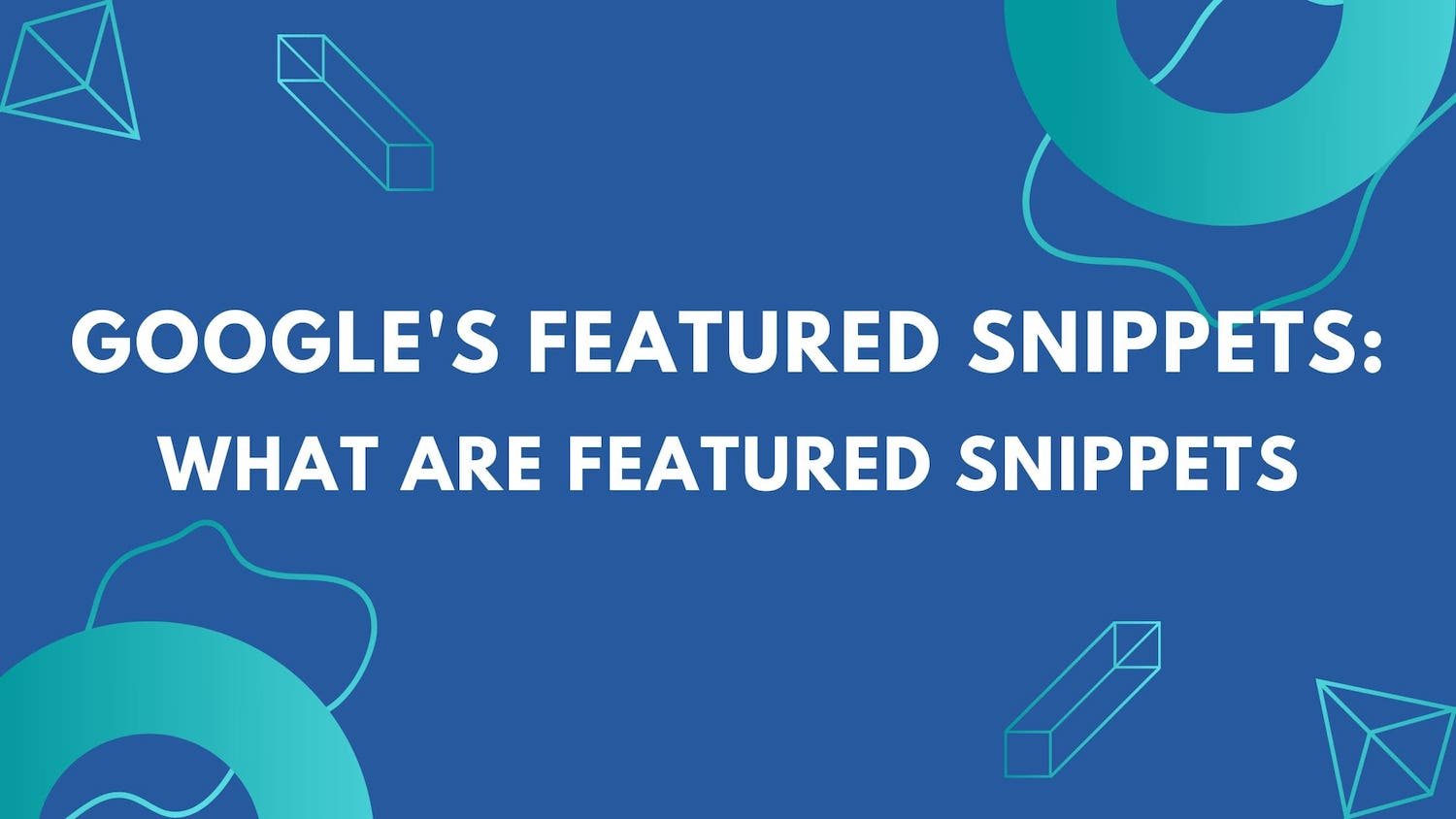Google’s featured snippets on their search engine results pages (SERPs) are coveted positions and one of the best ways to increase website traffic to your website. There are four types of featured snippets that can be won which will propel your page to the sought after SERP position 0 on Google Search. If you are wondering why featured snippets are important, then you have come to the right place! We will provide you with information on why snippets are important, and how to optimize your content for them – i.e. optimal feature snippet length!
In this article we discuss the different aspects of a Google featured snippet and provide a features snipper overview. Moreover, we will discuss why your website should aim to win feature snippets and should be a component of your content marketing efforts, for driving organic traffic. We will cover the following topics:
Let’s jump right in and discuss the featured snippet definition.
Table of Contents
Featured Snippet Definition
There are four types of featured snippets including definitions, tables, steps and lists, which Google search automatically compiles and displays to searchers to answer their query. These featured snippets will be displayed at the top of Google search results in order to provide immediate answers and information.
The different types of snippets in search engine optimization (SEO) are based on Google’s massive amount of data to present a certain type of information to its user. Whereas, many how to queries – like ‘How to dribble a basketball’ – will return a video snippet to the Google searcher. This is because Google has the information and data, to show that is the type of content people are looking for. Therefore, when you are wondering ‘what are featured snippets’ you should realize that these are dynamic pieces of content or information, thats main purpose it to present information to the user in the fastest way possible.
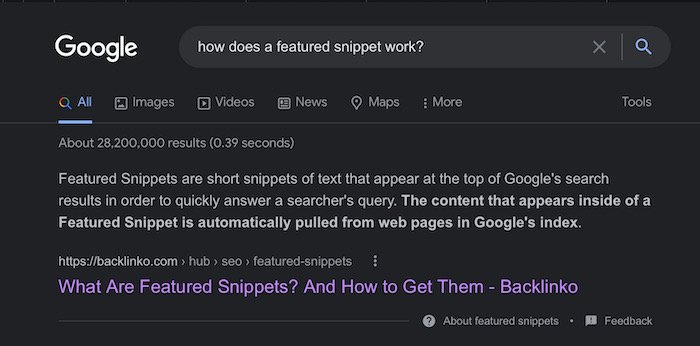
Therefore, while targeting snippets on Google, make sure you understand the search intent, and research which type of snippets are being presented by Google. If you haven’t gathered yet, feature snippets are extremely important for the performance of a website. Now let’s examine, exactly why are featured snippets important!
Note: Featured snippets are different from rich snippets. Both are important for SEO, but they are two different concepts. Need more information on rich snippets and featured snippets? Have a look at what are the differences between rich snippets and featured snippets.
Featured Snippets Length
A suitable length for a featured snippet paragraph is approximately 40 to 50 words, equivalent to approximately 300 characters.
Why are Featured Snippets Important
Feature Snippets are important, as they provide websites with an opportunity to have their website and information presented to search users above the rest of the Google SERP results. Winning featured snippets will increase a website’s organic traffic, and click through rate.
Let us break this down further and look at two primary reasons why Featured snippets are important.
One, a Google snippet provides an opportunity to get increased click through rates without ranking number 1 on SERPs. By winning a snippet, your website will be propelled to the top featured snippet position for a particular search query. By ranking in this position, Google is showing search users that the website is trusted, and has high-quality content. Being featured in one of the four different types of featured snippets, is considered so important, that SEO experts actually consider featured snippet boxes as ‘Position 0’ when it comes to SERPs.
The second way is that when there are featured snippets being shown to searchers, the ‘no click searches’ increase. This is because the featured snippet does its job: provides the exact information the searcher was looking for. This means that search engine users are less likely to continue to scroll through the SERP results.
Usually, one of two things happen when a user sees a featured snippet. One, they find the information they are looking for and the users search ends there. Or, two, the person clicks on the featured snippet winner as they trust Google to present the best information possible in the SERP positions. However, all that being said, it should not hold your website and content marketing efforts back from going after a SERP feature or a rich snippet.
There are many reasons why you should aim for the featured answer boxes. Below we have listed out 3 reasons why winning snippets should be a crucial part of your SEO strategy!
1. Higher organic traffic
Organic traffic is the lifeblood of any website or blog. You will not be successful if you’re not getting enough organic traffic. However, just because you’re not getting as much traffic as you’d like doesn’t mean you should give up. You can do various things to improve your organic traffic, and one of them is to get featured in Google’s SERP.
Getting featured in the SERP is a great way to increase traffic as well as your conversion rate because it puts you at the top of the search results. People are more likely to click on a featured result than one that is not, so being featured can significantly increase the amount of traffic you get. And, of course, the more traffic you get, the better your chances of success.
So if you’re looking for ways to improve your organic traffic, getting featured in Google’s SERP should be at the top of your list. It’s a great way to get more exposure for your website or blog and boost your traffic levels. So what are you waiting for? Start working on getting featured today!
2. Majority of the users click on the featured snippet
Being featured in Google Snippets can be a huge boon for your website. Not only does it give you higher organic traffic, but it also gives you a higher advantage over other results. The featured impact is bigger, more eye-catching, and offers a direct answer. As a result, people are more tempted to click on it rather than scroll down to other search results.
In addition, being featured in snippets can help you to build trust with potential customers. When people see that you are featured in a Google search, they are more likely to believe that you are an authoritative source of information. As a result, they are more likely to visit your website and make a purchase. So if you’re looking to increase website traffic and your bottom line, being featured in Google Snippets is the way to go.
3. Increase authority
Being featured on a blog is like getting a pat from Google. It’s a way of saying, “Hey, we like your stuff!” And when Google likes your stuff, that means searchers are more likely to find it useful. That’s because being featured gives your voice authority. When your blog appears in the featured answer box, searchers are more likely to trust what you say.
After all, if Google trusts you enough to feature your blog, then you must be an expert on the subject, right? So if you’re looking to build trust and authority, aim to get featured on as many blogs as possible. It’ll do wonders for your search engine visibility and bottom line.
Now that we know why featured snippets are important, let’s take a look at some facts about answer targets that can drive home their importance.
Featured Snippet Facts:
- Featured snippets get approximately 8% of all clicks
- 11.84% of all queries have a featured snippet
- Featured Snippets length matters, and the average and maximum length are well known (see tables below)
- The average definition snippet is between 40-60 words long.
- 99.58% of featured pages already rank in the top 10 of Google search.
- 70% of snippets came from websites outside of the first organic search result position.
- Paragraphs (50%) and lists (37%) are the most common types of featured snippets
- People Also Ask boxes are on 93.8% of featured snippet SERPs
How does Google Choose Featured Snippets
Google featured snippets is an automated process that displays information that directly answers the searchers particular query. It is a feature that is found on SERPs where the snippet information or ‘answer target’ comes before the page’s link. Which is different from the standard format Google uses to display results.
With these key features in mind, during the crawling and indexing of pages, Google’s spiders help collect information to determine if a blog post’s content can be used as a snippet. Google will automatically pull out specific content and information that it believes answers the particular search request the best.
However, we know that the algorithms that power Google’s search engine are constantly being updated, and the company doesn’t release detailed information on how they work.However, we know that Google takes a number of factors into account when choosing featured snippets. These include the relevance of the content to the query, the quality of the writing, and the popularity of the source material. In addition, Google may also consider whether a featured snippet would be useful to users and whether it will likely generate clicks.
As Google’s algorithms continue to evolve, we expect featured snippets to become more and more sophisticated. However, even though Google automatically chooses snippets to feature on their search engine results page, it is possible to develop content in a manner that will help you influence your chance of winning the snippets.
In the next section we discuss the different types of featured snippets and how to increase your chances of winning them.
What are the Types of Featured Snippets?
There are four types of featured snippets: paragraph, tables, lists, and videos. Depending on the type of search Google will present a different type of snippet. Each snippet has a different purpose and website need to target the appropriate type to win the snippet.
Remember all types of featured snippets are important to compete for, even a paragraph snippet (paragraph snippets are also known as definition and answer targets). Moreover, by going for Google’s featured snippets in the search result, you can boost you content marketing efforts.
Let’s now jump into each type of featured snippet and discuss it in further detail.
1. Definition, or Answer Target Featured Snippet
Definition or answer snippets are short (usually 40-60 words), concise pieces of information that answer a specific question. These snippets usually answer ‘What is’ questions, or other short answer questions. Moreover, they tend to be long-tail keywords.
When attempting to win this featured snippet opportunity, best practices say to use the particular ‘What is X’ question as a header tag to prime Google for the following paragraph featured snippet that you are targeting. Additionally, make sure to use your keyword and long tail keyword phrase in the answer section portion of your content.
HubSpot does a great job showcasing how to set up content to win Answer Target Featured Snippets:
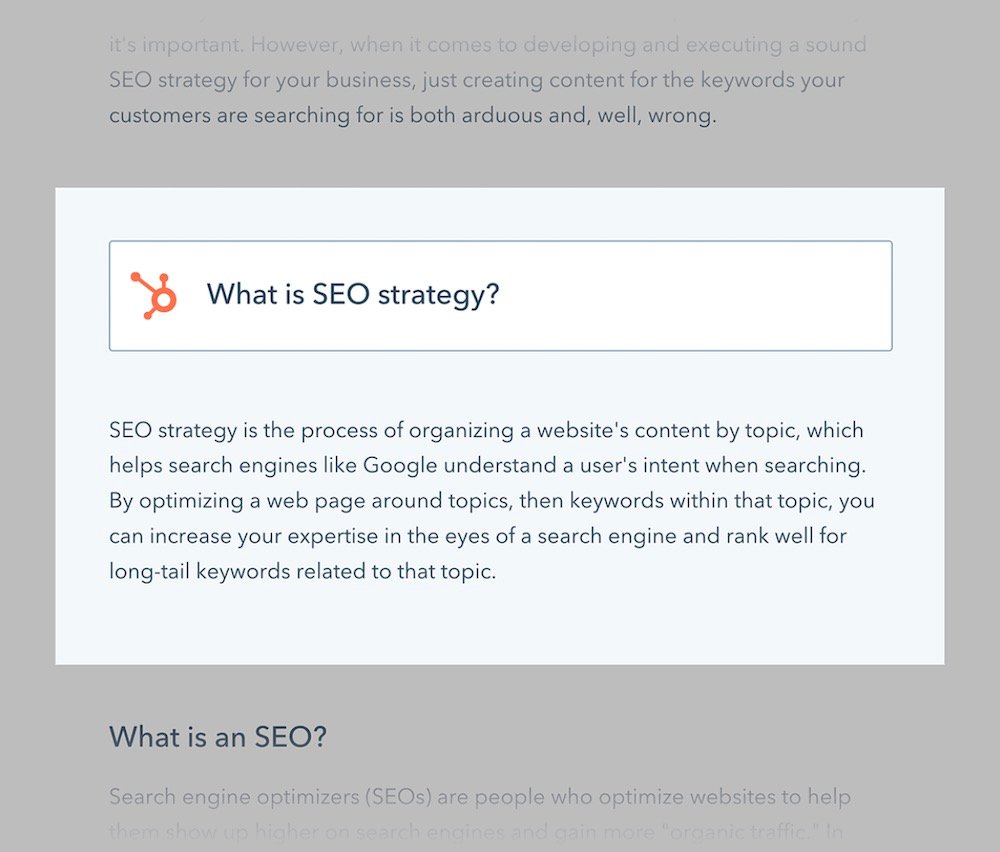
Below is an example of what a definition, or answer target featured snippet looks like on Google:

Finally, a key element to remember while targeting definition snippets is to ensure that the answer or definition is objective. Meaning, it does not contain any sort of opinion on the topic.
This is crucial as for these types of snippets, Google is not looking for opinions on the matter, only factual information. Think of how a dictionary lists out information and details, and strive to match that style.
2. Tables as Snippets
Unlike the other feature snippets, Google compiles the table snippet from tables that already exist in your content. In other words, Google is not creating table snippets by itself.
That means in order to win a table snippet, you will need to use one in your article to display your content. Therefore, it is key that you use the correct HTML formatting (or use CMS like WordPress) to design your table. This usually involves having the HTML <tr> tag, which allows for Google to easily read and process the table.
Below is an example of what a table featured snippet looks like on Google:
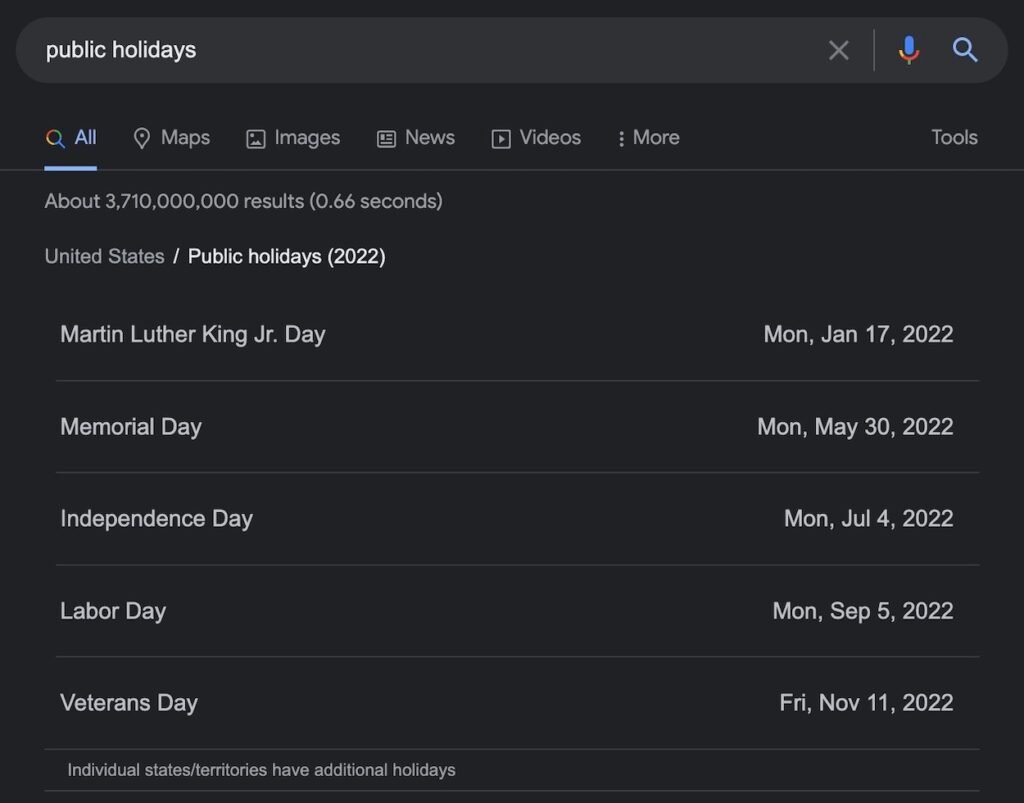
3. Bullet and Number Listicle featured Snippets
Within the list snippet category there are two different types: Ordered and Unordered. Google tends to display Ordered Lists for search queries that need a set of steps in order to accomplish the task. Additionally, ordered list feature snippets can be used to display rankings.
Below is an example of what a ordered list featured snippet looks like on Google:
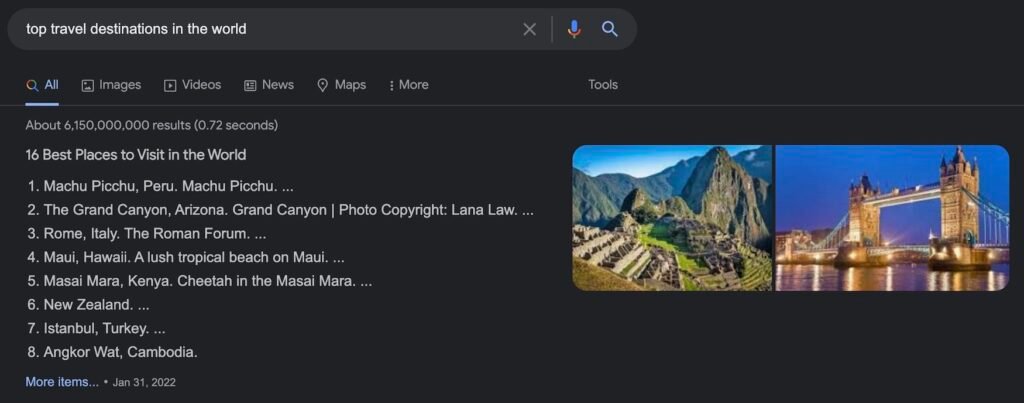
Google uses unordered lists to present information that doesn’t rely on previous steps being completed or that do not have any ranking associated with them.
Below is an example of what a unordered list featured snippet looks like on Google:
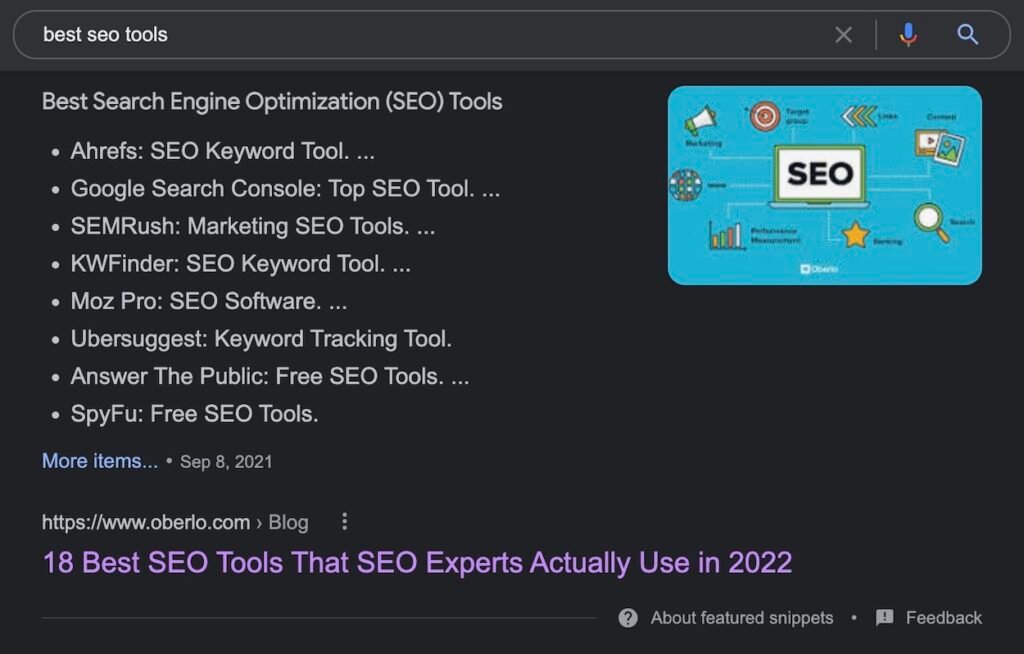
4. Video Snippets
Google has been trending in the direction of displaying more video snippets to answer the questions of its searchers. Videos are typically used to answer ‘how to’ questions, and provide quick solutions and actionable steps to complete whatever task the searcher is looking to accomplish.
Below is an example of what a video featured snippet looks like on Google:

How to Win Featured Snippets And Optimize For Them?
First, research which keywords Google is already showing featured snippets for. Next, understand the searchers intent behind the search query and develop content that provides a concise answer or response to the question. Finally, write high quality content that will rank well by itself, as 99% of feature snippets come from pages already ranking in the top 10.
It’s important to remember that Google is constantly changing its algorithms. This means it’s important to stay on top of the latest trends to ensure that your website continues to rank highly. Regularly monitoring your website’s performance and adjusting your strategy accordingly can help you maintain a top ranking.
The featured snippet algorithm is constantly changing, so it’s important to keep an eye on your website’s performance and adjust your strategy as needed. By providing searchers with the information they’re looking for, you can improve your website’s ranking on Google and attract new visitors.
If you follow these tips, you can improve your website’s ranking on Google and increase your chances of being featured in a featured snippet. By providing searchers with the information they’re looking for, you can boost your traffic and visibility.
Let’s dive into each of these key strategies to winning feature snippets a little further.
1. Know which queries Google shows feature snippets for
In order to win a feature snippet, there needs to be one. Therefore, the first thing to conduct keyword research and then see which ones have feature snippets displayed on Google SERPs.
It is important to do your research first for two reasons.
One, it will be very difficult to get Google to create a new feature snippet if one doesn’t exist already.
That being said, it is still a good idea to develop content in a way that sets it up to win feature snippets in the future, if Google decides to display one for that particular query.
The second reason it is important to research first is that you will be able to see which questions have snippets, and what type of snippets they are. Whereas, if you know what type of snippet is being displayed, you can format your content accordingly.
2. Construct concise answers, responses and content for the query
Google is looking for feature snippets that are concise and succinct responses to each query. Therefore, while developing content to target the snippets, try to cut out all filler words, and avoid writing for length.
Writing content that is concise with no extra ‘fat’ can be difficult. A few strategies that Clear Door SEO uses to write concisely are:
- Conduct multiple audits and edits of the content to ensure that it is as specific as possible. Utilize your team to go through the content as well. Multiple editors and iterations can help develop the best content possible
- Use Grammarly. Grammarly can be a great tool to help make your content more concise and specific. Even their free tool will help out with editing and ensuring that the content is as good as it can be. Just remember, it only edits, not creates. So, if the content is not good from the beginning, Grammarly won’t be able to do anything about it.
When developing content for each snippet, you can use the data developed by Moz which showcases the optimal lengths for the different types of feature snippets.
Optimal Definition and Answer Target Featured Snippet Length:
| Definition and Answer Target Snippet Length | Words | Characters |
|---|---|---|
| Average | 45 | 293 |
| Maximum | 97 | 752 |
Optimal List Featured Snippet Length:
| List Snippet Length | Items | Words Per Item |
|---|---|---|
| Average | 4.2 | 10.8 |
| Maximum | 8 | 64 |
Optimal Table Featured Snippet Length:
| List Snippet Length | Rows | Columns |
|---|---|---|
| Average | 3.6 | 2.5 |
| Maximum | 9 | 3 |
3. Write factual content and avoid opinions
Writing fact based content may be one of the most important aspects of targeting feature snippets. This is because Google is looking for concise answers to particular questions that their users are searching for.
Google has been consistent when it comes to their snippets as they tend to showcase numbers, steps and lists. Moreover, typically they display answer targets that list actual ingredients, number of steps, time to cook, year and city of birth, or in other words, specific facts.
Therefore, following best practices when developing content for Google snippets means using specific data, numbers and names in the content. To inform Google that you know exactly what you are talking about. Be as factual as possible!
4. Determine featured snippets your competitors rank for
The first thing you should do when trying to rank for Google’s featured snippets is to figure out which featured snippets your competitors are ranking for. If you’re like most people, you’ve probably looked at Google’s featured snippets and thought, “How do I get my website to rank for those?” After all, featured snippets are prominently displayed at the top of the search results page and often receive a high click-through rate.
Fortunately, you can do a few things to improve your chances of ranking for featured snippets. The first step is determining which featured snippets your competitors are ranking for. You can use a tool like SEMrush to see which keywords your competitors rank for in Google’s featured snippets.
Once you’ve identified some potential keywords, you can then start optimizing your website for those keywords. Some optimization tips include using keyword-rich titles and meta descriptions and creating high-quality content relevant to the searcher’s intent. Following these steps can improve your chances of ranking in Google’s featured snippets.
5. Optimize your content for featured snippets
Once you know which featured snippets your competitors are ranking for, you can start optimizing your content to try and rank for those same snippets.
If you want to take your content marketing efforts to the next level, it’s time to start thinking about featured snippets. Featured snippets are brief answers to queries at the top of search engine results pages. They’re designed to provide users with quick, concise information that doesn’t require them to click through to a website.
While featured snippets have been around for a few years, they’ve only recently begun to gain traction with content marketers. That’s because ranking for a featured snippet can be a major coup. Not only does it mean that more people are seeing your content, but it also gives you a significant advantage over your competitors. If you’re not sure where to start, don’t worry. Here are three tips for optimizing your content for featured snippets.
- Conduct a competitor analysis and Identify which featured snippets your competitors are ranking for.
- Optimize your content to try and rank for those same snippets.
- Keep an eye on your progress and adjust your strategy as needed.
By following these tips, you can boost your content marketing efforts and start driving more traffic to your website.
6. Optimize your title tags and meta descriptions
Optimize your title tags and header tags to include keywords associated with featured snippets.
As any SEO expert knows, optimizing your website for search engines is essential for driving traffic and generating leads. One important element of SEO is choosing the right keywords to target. In recent years, featured snippets have become an increasingly important factor in determining which results appear at the top of the search page. As a result, it’s essential to choose keywords that are associated with featured snippets.
Fortunately, there are a few easy ways to find these keywords. First, try entering your target keyword into Google and scrolling to the bottom of the search results page. If there are any featured snippets at the top of the page, you’ll see a list of keywords that are associated with those snippets.
You can also use Google’s Keyword Planner tool to find keywords with high search volume and low competition. By including these keywords in your title tags and meta descriptions, you can increase your chances of appearing in featured snippets — and driving more traffic to your website.
7. Use structured data on your website
Use structured data on your website to help Google understand the content on your pages and potentially display it in featured snippets.
Google’s mission is to “organize the world’s information and make it universally accessible and useful.” The search engine relies on algorithms to sort and present information to users to achieve this goal. However, algorithms are not perfect, and they often struggle to understand the nuances of human language.
This is where structured data comes in. Structured data from (using Schema) typically is for helping a website with showing rich snippets on Google search results. However, it has been shown to help Google better understand the content on your pages and as a result, increase the chance of your content to win featured snippets.
Additionally, structured data can help your pages be included in other Google products, such as Knowledge Graphs and Price comparison features. While adding structured data to your website does require some technical knowledge, it is well worth the effort as it can help your pages to reach a wider audience.
8. Keep track of your progress
Keeping track of your progress over time and monitoring the opportunities you have to win featured snippets can be the biggest factor in your success. This is because once you start cracking the top 10 SERP results for keywords, you should start going after and optimizing your content to win snippets.
As an SEO professional, a featured snippet is one of the most exciting things you can see in your Google Search Console and Google Analytics. The section at the top of the search results gives you a quick answer to particular question. It’s essentially free advertising, and of course, you want your website to be the one that shows up. But how can you tell if you’re progressing towards ranking for featured snippets?
The simplest way is to keep track of your progress over time. Look at your Search Console data from month to month, and see if there’s an increase in the number of featured snippets that your website appears in. If so, then you know you’re on the right track! Of course, this isn’t the only metric you should pay attention to. But it’s definitely one worth monitoring as you strive to improve your website’s SEO.
A few additional tools that will help you see which keywords and phrases have featured snippets include:
- Ubersuggest
- Ahrefs
- SEMrush
By using these SEO tools you can see which terms have featured snippets attached to them, and which snippets you have an opportunity to win.
These tips can help you get started with trying to rank in Google’s featured snippet. Try implementing some of these optimization techniques on your website and see how it goes!
Key Takeaways: Featured Snippets
Featured snippets are a type of search result that appears in Google’s search results. They are designed to give users quick and relevant information in response to their search queries.
These answer targets are drawn from various sources, including web pages, articles, and online books. Featured snippets typically appear at the top of the search results page, above the regular results.
Google’s featured snippets can be powerful tools to increase website traffic. Whereas, winning a snippet from Google will propel your website’s content to the ‘Position 0’ spot that SEO experts and content marketers dream of.
Although it may seem difficult to conduct featured snippet optimization and win Google snippets, there are strategic ways to develop content to win. Whereas, above we have included a table that showcases the optimal length of content for each type of snippet. Following these best practices, as well as writing concise factual content that contains your target keyword, can help you develop content for snippets currently available, as well as new ones that will be developed in the future.
Although the strategies listed above will help, they’re not a sure fire way to win features snippets. As data shows, 99% of the feature snippet winners already rank on the first page of SERPs, your initial strategy should be to focus on content writing for SEO and ranking in the top 10 SERPs.
Clear Door SEO is a Portland based SEO company that works with small businesses to rank well on Google and increase website traffic by offering specialized SEO services. If your company is looking to double down on its digital marketing efforts and capitalize on organic website traffic, and increase your conversion rate more visitors into customers, you can contact us. We specialize in an array of SEO services including content writing and auditing. Contact us today to take your website to the next level!
